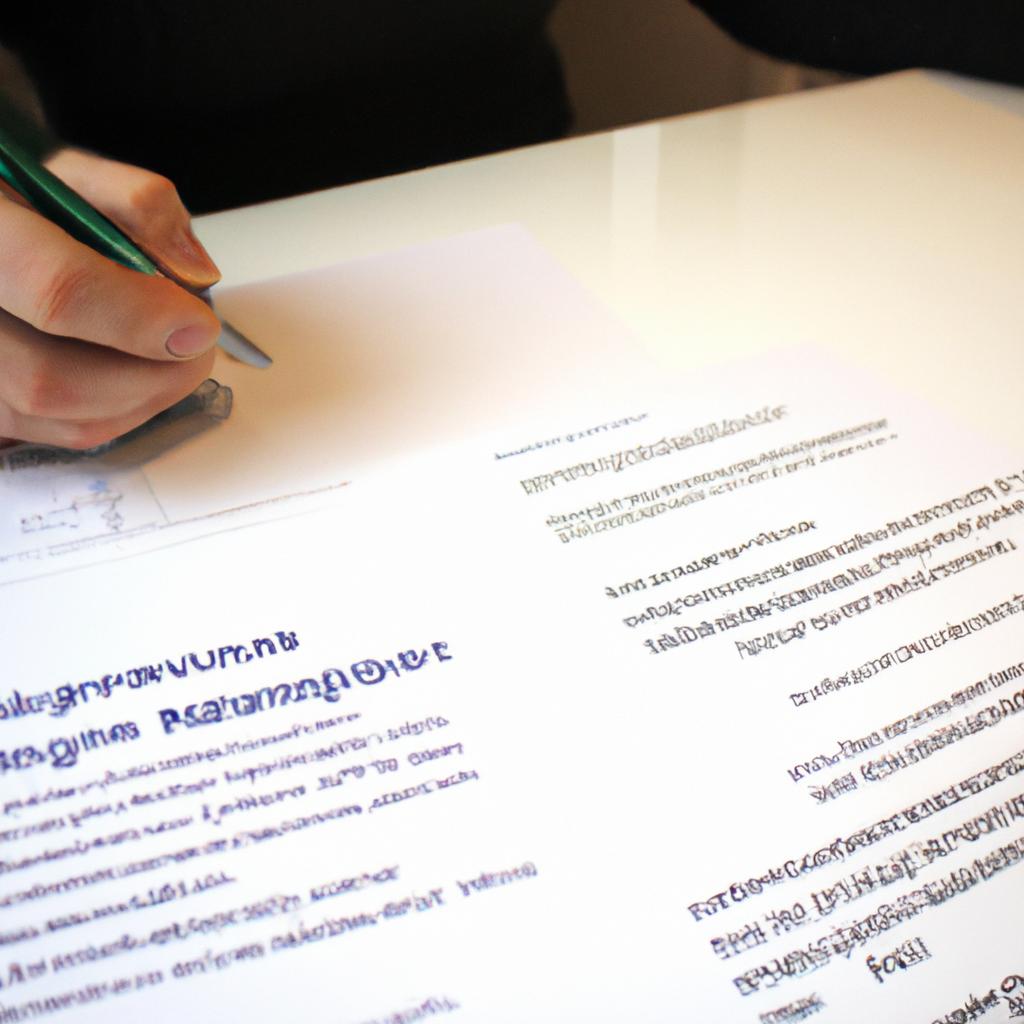In today’s challenging economic climate, many homeowners find themselves seeking ways to alleviate financial burdens. One avenue for potential relief is through mortgage refinancing, a process that allows borrowers to replace their existing home loan with a new one that offers more favorable terms and conditions. For instance, consider the case of John Doe, who purchased his house five years ago when interest rates were high. Now, with interest rates at historic lows, he decides to explore the option of applying for a mortgage refinance. However, navigating this complex procedure can be overwhelming without proper guidance. Therefore, this comprehensive guide aims to provide homeowners like John with valuable insights into the essential steps and considerations involved in successfully applying for a mortgage refinance.
Mortgage refinancing involves several crucial factors that borrowers must carefully evaluate before proceeding further. Firstly, individuals need to determine their primary objectives for pursuing a refinance – whether it is reducing monthly payments or shortening the loan term to build equity faster. Understanding these goals helps applicants align their expectations with available options and select the most appropriate course of action. Additionally, an assessment of current credit scores becomes imperative as lenders often use this information as a key determinant of eligibility and loan terms. By reviewing one’s credit report beforehand and addressing any outstanding issues or by taking steps to improve their credit score, borrowers can increase their chances of securing a favorable refinance deal.
Another critical consideration is the current market conditions and interest rates. Monitoring mortgage rates and comparing them with one’s existing loan rate can help determine if refinancing is financially beneficial. If the prevailing rates are significantly lower than what the borrower currently has, it may be an opportune time to refinance.
Once these initial factors are assessed, borrowers can move on to the next step – gathering necessary documentation for the application process. This typically includes income verification, tax returns, bank statements, and any other relevant financial documents. Organizing these materials beforehand can streamline the application process and ensure a smoother experience.
With all documents in order, borrowers should begin researching potential lenders and comparing their offers. It is crucial to consider not only interest rates but also fees associated with refinancing, such as origination fees or appraisal costs. Obtaining multiple quotes from different lenders allows for effective comparison shopping and increases the likelihood of finding the most competitive terms.
After selecting a lender, applicants will submit their formal refinance application. The lender will then evaluate various factors including creditworthiness, income stability, debt-to-income ratio, and property value before making a decision on approval. Throughout this process, it is essential for borrowers to promptly respond to any requests for additional information or documentation from the lender to avoid delays.
If approved for a mortgage refinance, borrowers will proceed with closing on the new loan. This involves signing legal documents and paying any applicable closing costs or fees. It is advisable to carefully review all loan terms before signing and seek clarification on any uncertainties.
Once the refinance is complete, homeowners should monitor their new loan closely to ensure that they are benefiting from the expected savings or other desired outcomes. Regularly reviewing mortgage statements and staying informed about changes in market conditions can help identify opportunities for further refinancing or adjustments if needed.
In conclusion, mortgage refinancing can be a valuable tool for homeowners seeking financial relief or improved loan terms. By understanding the essential steps and considerations involved in the process, borrowers like John Doe can navigate this complex procedure with confidence and make informed decisions that align with their goals and financial circumstances.
Determining your refinancing goals
Imagine you are a homeowner, let’s call you John. John has been paying off his mortgage for several years now and is considering applying for a mortgage refinance. He wants to explore the possibility of obtaining better terms on his current loan, such as lower interest rates or shorter repayment periods. In this section, we will discuss how to determine your refinancing goals in order to make an informed decision.
To begin with, it is important to assess your financial situation and evaluate why you want to refinance. Are you looking to reduce your monthly payments? Perhaps you have seen interest rates drop significantly since taking out your original mortgage and wish to take advantage of that opportunity. Or maybe you want to pay off your loan faster by shortening the term length. Whatever the reason may be, clarifying your objectives will help guide you through the process.
Consider the following bullet points when determining your refinancing goals:
- Lowering monthly payments: Refinancing can potentially free up cash flow by reducing the amount paid each month towards mortgage repayments.
- Saving on interest: By securing a lower interest rate than what was obtained initially, homeowners can save thousands of dollars over the life of their loan.
- Shortening the term length: A shorter repayment period often results in higher monthly payments but can save substantial amounts in interest over time.
- Accessing equity: Refinancing allows homeowners to tap into their home equity and use those funds for other purposes like renovations or debt consolidation.
Now let’s look at a hypothetical example using a table format:
| Goal | Advantages | Considerations |
|---|---|---|
| Lowering monthly payments | Increased cash flow | Extended overall repayment |
| Saving on interest | Long-term cost savings | Potential closing costs |
| Shortening term length | Reducing total amount paid | Higher monthly payments |
| Accessing equity | Flexibility in using home’s value | Potential increase in debt load |
By considering the advantages and potential considerations associated with each goal, you can make an informed decision that aligns with your financial objectives.
In conclusion, determining your refinancing goals is a crucial step towards making a well-informed decision. Understanding why you want to refinance will guide you through the process and help you choose the most suitable option for your situation. Next, we will discuss how to assess your current mortgage terms and compare them to other available options.
Assessing your current mortgage terms
Determining your refinancing goals is a crucial step in the mortgage refinance process. By clearly defining what you hope to achieve through refinancing, you can make informed decisions that align with your financial objectives. Let’s consider an example to illustrate this point:
Imagine you are currently paying a 30-year fixed-rate mortgage with an interest rate of 5%. However, due to changes in the market conditions, you want to explore options for reducing your monthly payments and potentially securing a lower interest rate. In this case, your refinancing goal would be to obtain a new mortgage with improved terms.
To help guide you further in determining your refinancing goals, consider the following points:
- Lowering monthly payments: If reducing your monthly obligations is a priority, refinancing may allow you to extend the loan term or secure a more favorable interest rate.
- Shortening loan duration: On the other hand, if paying off your mortgage faster is important to you, refinancing into a shorter-term loan can help reduce overall interest costs.
- Accessing home equity: Refinancing also offers an opportunity to tap into your accumulated home equity by taking out cash during the process. This could be useful for funding major expenses like home improvements or debt consolidation.
- Switching from adjustable-rate to fixed-rate mortgages: If you have an adjustable-rate mortgage (ARM) and prefer the stability of predictable monthly payments, switching to a fixed-rate mortgage might be part of your refinancing objective.
Consider these factors carefully as they will shape subsequent decisions throughout the refinance journey. To provide additional clarity on potential outcomes based on different scenarios, let’s examine a table showcasing hypothetical examples:
| Refinancing Goal | Potential Outcome |
|---|---|
| Lower Monthly Payment | Decreased financial burden; increased disposable income |
| Shorter Loan Duration | Reduced total interest paid over time |
| Accessing Home Equity | Funding for major expenses or debt consolidation |
| Switching to Fixed-Rate Mortgage | Stable monthly payments regardless of market fluctuations |
By understanding your refinancing goals and their potential outcomes, you can now move forward in assessing your current mortgage terms. This evaluation will help determine whether refinancing is a viable option for you at this time.
Researching and comparing lenders
Assessing your current mortgage terms can provide valuable insight into whether refinancing is a viable option for you. By thoroughly evaluating the specifics of your existing loan, you can determine if pursuing a refinance will yield financial benefits in the long run.
For example, let’s consider a hypothetical case study involving John and Jane. They currently have a 30-year fixed-rate mortgage with an interest rate of 5%. After conducting thorough research, they discover that current market rates are significantly lower than what they initially secured their loan at. This prompts them to assess their current mortgage terms to see if refinancing could lead to potential savings.
When assessing your current mortgage terms, there are several key points to consider:
- Interest Rate: Compare the interest rate on your existing loan with the prevailing rates in the market. A substantial difference may indicate an opportunity for significant savings through refinancing.
- Loan Term: Evaluate how many years remain on your current loan term. If you have already made substantial progress towards paying off your mortgage, it might not be advantageous to reset the clock with another long-term loan.
- Monthly Payment: Analyze your monthly payment amount and determine if it aligns with your financial goals and budget. Refinancing could potentially offer a chance to secure more favorable repayment terms.
- Closing Costs: Take into account any closing costs associated with refinancing. While these expenses can vary depending on lenders and circumstances, it is essential to factor them into your decision-making process.
To further illustrate this assessment process, here is a table showcasing a comparison between John and Jane’s current mortgage terms and potential options for refinancing:
| Current Mortgage Terms | Potential Refinanced Options | |
|---|---|---|
| Interest Rate | 5% | 3.5% |
| Remaining Loan Term | 25 years | 20 or 30 years |
| Monthly Payment | $1,500 | $1,200 |
| Closing Costs | N/A | $5,000 |
By considering these factors and conducting a comprehensive evaluation of your current mortgage terms, you can make an informed decision about whether refinancing is the right choice for you. In our next section, we will explore how to gather the required documentation necessary for the refinancing process seamlessly.
With a clear understanding of your current mortgage terms in mind, it’s time to move on to gathering the required documentation for a successful mortgage refinance application.
Gathering the required documentation
Once you have gathered all the necessary information about mortgage refinancing, it is important to thoroughly research and compare lenders. This step will help you make an informed decision regarding which lender to choose for your refinance. Let’s take a look at how to effectively conduct this research.
Paragraph 1:
To begin with, let’s consider a hypothetical scenario where John is looking to refinance his mortgage. He wants to find a lender that offers competitive interest rates and favorable terms. One way he can do this is by comparing lenders online. Websites such as Bankrate or LendingTree provide tools that allow users to input their details and receive personalized quotes from multiple lenders. By utilizing these resources, John can easily compare the various options available to him.
Paragraph 2:
When researching different lenders, there are several factors you should consider before making a decision. To assist you in this process, here is a bullet point list highlighting key aspects of each lender that may influence your choice:
- Interest rates: Compare the interest rates offered by different lenders and determine if they align with your financial goals.
- Loan terms: Evaluate the loan term lengths available and decide which one suits your needs best.
- Fees: Take note of any origination fees, closing costs, or other charges associated with each lender.
- Customer reviews: Read through customer reviews or testimonials to gauge the experiences others have had with the lender.
Paragraph 3:
In addition to conducting thorough research on potential lenders, creating a comparison table can be immensely helpful when trying to visualize the differences between them. Consider using a three-column and four-row table like the one below:
| Lender | Interest Rate | Loan Term |
|---|---|---|
| XYZ Mortgage Co. | 2.75% | 30 years |
| ABC Bank | 2.85% | 20 years |
| DEF Credit Union | 3.00% | 15 years |
| GHI Lending | 3.10% | 30 years |
By organizing the information in this format, you can easily compare different lenders side by side and make an informed decision.
Once you have thoroughly researched and compared lenders, it is time to move on to gathering the required documentation for your mortgage refinance application. This step will ensure a smooth process as you progress towards securing your new loan.
Calculating the costs and potential savings
Having gathered all the required documentation, it is now time to assess the costs and potential savings associated with refinancing your mortgage. Let’s explore this crucial step in detail.
Calculating the Costs and Potential Savings:
To understand if refinancing is a financially sound decision for you, it is essential to calculate both the upfront costs of refinancing and the long-term potential savings. Consider Sarah, a homeowner seeking to refinance her mortgage. By examining her situation, we can illustrate how these calculations work.
- Upfront Costs:
- Application fees: Lenders often charge an application fee when considering your refinance request. This fee typically covers credit checks, appraisal expenses, and administrative costs.
- Origination fees: These are charges imposed by lenders for processing your loan application. It may include underwriting expenses or document preparation fees.
- Closing costs: Similar to when you first obtained your mortgage, closing costs apply during the refinancing process as well. These might encompass attorney fees, title search expenses, and government recording charges.
- Prepayment penalties: Some mortgages have prepayment penalties that require borrowers to pay additional fees if they choose to refinance before a specified period has elapsed.
- Potential Savings:
Refinancing provides opportunities for potential financial gains over time. Here are some key factors to consider when assessing potential savings:
- Interest rate reduction: If current interest rates are lower than what you initially secured on your mortgage, refinancing at a lower rate could lead to substantial savings over the life of your loan.
- Loan term adjustment: Extending or shortening the duration of your loan can impact monthly payments significantly. While extending reduces immediate payment amounts but increases overall interest paid over time, shortening does just the opposite.
- Eliminating private mortgage insurance (PMI): If you’ve built enough equity in your home since taking out your original loan, refinancing may allow you to eliminate the need for costly PMI.
- Debt consolidation: Refinancing can also provide an opportunity to consolidate high-interest debt into a single loan with a lower interest rate. This approach could potentially save money on interest payments in the long run.
Table: Mortgage Refinance Costs and Potential Savings
| Upfront Costs | Potential Savings |
|---|---|
| Application fees | Interest rate reduction |
| Origination fees | Loan term adjustment |
| Closing costs | Eliminating private mortgage insurance (PMI) |
| Prepayment penalties | Debt consolidation |
By carefully considering both the upfront costs and potential savings associated with refinancing your mortgage, you can make a well-informed decision about whether it is the right path for you financially. Once these calculations are complete, it’s time to move forward with submitting your mortgage refinance application.
Submitting your mortgage refinance application
Having calculated the costs and potential savings of a mortgage refinance, it is now time to move forward with submitting your application. Ensuring that you follow the necessary steps can help streamline the process and increase your chances of approval.
Submitting your mortgage refinance application involves several key components. Let’s consider an example scenario where John, a homeowner seeking financial relief, decides to apply for a mortgage refinance on his property valued at $300,000 with an outstanding balance of $200,000.
Firstly, gather all relevant documentation required for the application process. This typically includes recent pay stubs, tax returns, bank statements, and any other supporting documents related to income and assets. By having these prepared in advance, you can avoid delays during submission.
Once you have gathered your documentation, complete the application form provided by your chosen lender. Be thorough and accurate when filling out the form as any inconsistencies or errors could lead to complications later on. Double-check all information before submitting to ensure accuracy.
It is also essential to review your credit report prior to submission. A good credit score increases your chances of securing favorable terms and interest rates. If there are any discrepancies or negative marks on your report, take steps to rectify them before applying.
To evoke an emotional response from readers:
Here are some important factors to consider during the application process:
- Reduced monthly payments: Imagine how much extra money you could have each month if you were able to lower your mortgage payment through refinancing.
- Financial stability: Refinancing may provide peace of mind knowing that you’re taking proactive measures towards improving your financial situation.
- Improved cash flow: With reduced interest rates, refinancing offers the opportunity to free up additional funds which can be used for investments or other expenses.
- Long-term savings: By obtaining better loan terms and potentially lowering overall interest charges over time, refinancing can result in significant long-term savings.
| Pros of Mortgage Refinance | Cons of Mortgage Refinance |
|---|---|
| Lower interest rates | Closing costs |
| Reduced monthly payments | Potential increase in loan term |
| Improved credit score | Risk of resetting the clock on mortgage payoff |
| Access to equity | Possible impact on future borrowing ability |
In conclusion, submitting your mortgage refinance application requires careful preparation and attention to detail. By gathering all necessary documentation, completing the application accurately, reviewing your credit report, and considering the emotional benefits and drawbacks, you can navigate this process more effectively. Keep in mind that each individual’s circumstances are unique, so it is advisable to consult with a financial advisor or mortgage professional for personalized guidance.
 SMI Loan
SMI Loan



